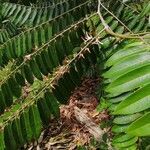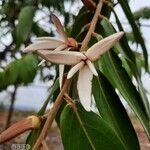A small tree. It grows about 7 m high. The branches are long and hang down. The leaves are narrow and pointed. They are shiny above and bluish underneath. The side veins are very faint. The leaves are regularly spaced and in a flat plane. The flowers have 2 rings of petals of different sizes. The flowers are white. The fruit have several lobes arranged like a cluster. The skin is light green. The flesh is red. The seeds are black.




